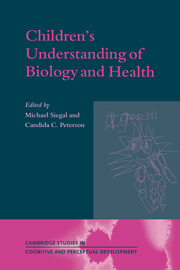Book contents
- Frontmatter
- Contents
- List of contributors
- Preface
- 1 Becoming mindful of biology and health: an introduction
- Part I Development of biological understanding
- Part II Health issues
- 5 What young children's understanding of contamination and contagion tells us about their concepts of illness
- 6 Children and pain
- 7 Children and food
- 8 The ethics of emaciation: moral connotations of body, self, and diet
- Part III Applications
- Appendix: Hypothetical dilemma vignettes
- Author index
- Subject index
6 - Children and pain
Published online by Cambridge University Press: 06 July 2010
- Frontmatter
- Contents
- List of contributors
- Preface
- 1 Becoming mindful of biology and health: an introduction
- Part I Development of biological understanding
- Part II Health issues
- 5 What young children's understanding of contamination and contagion tells us about their concepts of illness
- 6 Children and pain
- 7 Children and food
- 8 The ethics of emaciation: moral connotations of body, self, and diet
- Part III Applications
- Appendix: Hypothetical dilemma vignettes
- Author index
- Subject index
Summary
The presence of pain is the single most common reason why people seek help from doctors and other health professionals. Billions of dollars are spent every year on pain-killing drugs and on various other treatments for the relief of pain. Suffering due to chronic pain dominates the daily lives of some people, seriously affecting their ability to function normally and their overall quality of life.
Pain has a biological basis, reflecting the response by the body to a nociceptive stimulus. This pain-producing event may have an external origin (e.g., a skin cut or burn), or it may come from inside the body and be related to a physical illness (e.g., a migraine headache or arthritic joint). The pain response is potentially vital to the survival of the organism and thus serves an important evolutionary role.
Pain also has cognitive, affective, and behavioral components. The perception of pain varies as a function of the psychological state of the individual: it is likely to feel more intense when the person is anxious or tense or focusing on the injury. People may learn to manage ongoing pain through the use of various behavioral (e.g., relaxation) and cognitive (e.g., distraction, positive imagery) coping strategies.
These physiological and psychological factors contributing to the perception of pain are implicated in the influential gate-control theory proposed by Melzack and Wall (1965, 1982). Central to this theory is a gating mechanism located in the spinal cord that is controlled by ascending neural activity carrying messages from the periphery to the brain and by descending neural impulses carrying information from the cerebral cortex and brainstem.
- Type
- Chapter
- Information
- Children's Understanding of Biology and Health , pp. 131 - 160Publisher: Cambridge University PressPrint publication year: 1999
- 5
- Cited by



